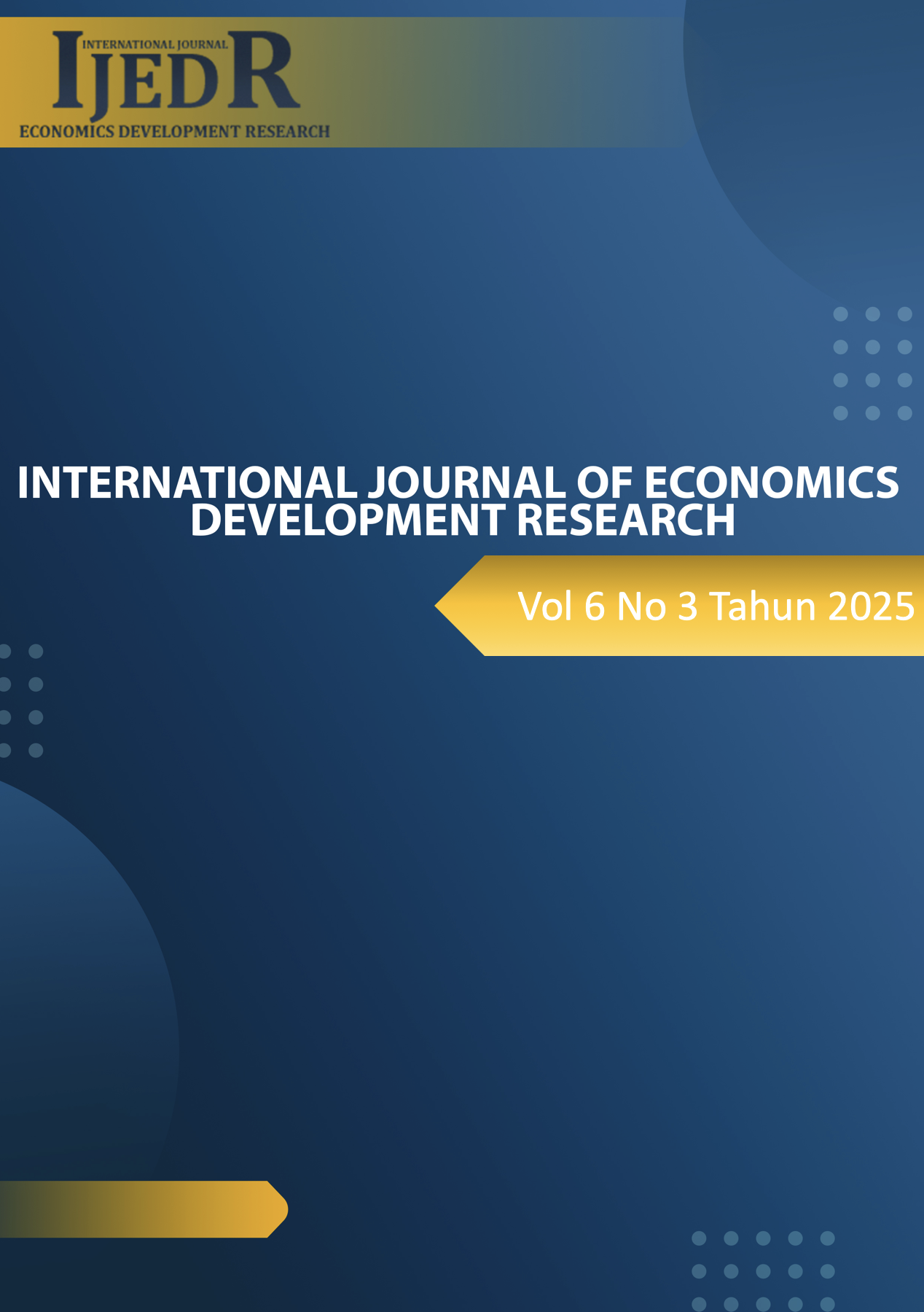The Economics of Precision: Comparing Attribute and Activity-Based Costing for Strategic Gain
DOI:
https://doi.org/10.37385/ijedr.v6i3.7702Keywords:
Attribute Based Costing, Activity Based Costing, Competitive Advantage, Cost of Goods Manufactured, Coffee ShopAbstract
This study aims to compare the effectiveness of Attribute Based Costing (ABC II) and Activity-Based Costing (ABC) methods in increasing the competitive advantage of Coffee Shop. A qualitative case study was conducted on three featured menus (Marine Ford, Alabasta, and So So Beer) at a Coffee Shop in Mataram. Data were collected through interviews, observations, and analysis of financial documents. The ABC method allocates costs based on production activities, including raw material, labor, and overhead costs, while ABC II focuses on product attributes to calculate raw material costs. The results show that ABC produces more accurate cost information with an average profit margin of IDR6,238.61 per product, while ABC II reduces raw material costs by 13-15%, resulting in an average profit margin of IDR15,348.94. However, ABC II does not take into account labor and overhead costs, making it less comprehensive. The combination of the two methods can improve the efficiency of raw material costs (ABC II) without neglecting the accuracy of comprehensive costs (ABC). This study concludes that ABC is more suitable for competitive pricing strategies, while the integration of ABC II within the ABC framework has the potential to optimize cost management. The implication of the study recommends the hybrid use of both methods to increase the profitability of coffee shops in a competitive market.
References
Al Dafaiy, S. M., & Al Kalaf, N. M. (2021). The role of attribute based costing in reducing quality costs. Journal of Al-Rafidain University College for Sciences, 44(1), 94–108. https://doi.org/10.55562/jrucs.v44i1.130
Al-Saadi, H. A. M., Al-Doori, N. A. F., & Al Samuria, S. M. B. (2021). The role of the cost leadership strategy using the activity based cost accounting (ABC) system in reducing costs. American Journal of Economics and Business Management, 6(10). https://doi.org/10.31150/ajebm.v6i10.2470
Alsayegh, M. F. (2020). Activity based costing around the world: Adoption, implementation, outcomes and criticism. Journal of Accounting and Finance in Emerging Economies, 6(1), 251–262. https://doi.org/10.26710/jafee.v6i1.1074
Anyadiegwu, P. E., & Ifurueze, S. M. (2020). Activity based costing from the perspective of competitive advantage: A study of Nigerian manufacturing firms. International Journal of Finance and Accounting, 5(1), 1–12. https://doi.org/10.47604/ijfa.128
Cidav, Z., Mandell, D., Pyne, J., Beidas, R., Curran, G., & Marcus, S. (2020). A pragmatic method for costing implementation strategies using time-driven activity-based costing. Implementation Science, 15(1), 1–15. https://doi.org/10.1186/s13012-020-00991-3
Darudiato, S., & Widjaja, Y. (2022). Production cost control using activity-based costing methods in information systems. International Journal of Informatics and Computation, 4(2), 25–35. https://doi.org/10.35842/ijicom.v4i2.54
Gunasekaran, A., & Sarhadi, M. (1998). Implementation of activity-based costing in manufacturing. International Journal of Production Economics, 56(1), 231–242. https://doi.org/10.1016/S0925-5273(97)00139-4
Horngren, C. T., Datar, S. M., & Rajan, M. V. (2021). Cost accounting: A managerial emphasis (17th ed.). Pearson Education.
Ittner, C. D. (1999). Activity-based costing concepts for quality improvement. European Management Journal, 17(5), 492–500. https://doi.org/10.1016/S0263-2373(99)00035-3
Kaplan, R. S., & Cooper, R. (1998). Cost & effect: Using integrated cost systems to drive profitability and performance. Harvard Business School Press.
Kumar, A., Sah, B., Singh, A. R., Deng, Y., He, X., Kumar, P., & Bansal, R. C. (2017). A review of multi-criteria decision making (MCDM) towards sustainable renewable energy development. Renewable and Sustainable Energy Reviews, 69, 596–609.
Lefebvre, P., & Romero-Mosquera, L. M. (2023). Application of the theory of constraints and activity-based costing for product costing. Journal of Management World, 2023(1), 28–34. https://doi.org/10.53935/jomw.v2023i1.230
Munandar, A., Maratis, J., Sugiyanto, D., & Kadlina. (2024). Implementation of activity-based costing to increase profits for traditional treatment providers. International Journal of Community Service, 3(1), 164–173. https://doi.org/10.55299/ijcs.v3i1.945
Nikmah, U. (2023). Comparative study of activity-based costing & time-driven activity-based costing in improving performance: A literature review. Journal of Business and Accounting, 25(1), 153–168. https://doi.org/10.34208/jba.v25i1.1591
Prawira, I. F. A. (2020). The difference of cost of good manufactured determination using traditional and activity-based costing method. International Journal Management Science and Business, 1(1). https://doi.org/10.17509/msb.v1i1.17104
Puspita, A. R. D., Syari, A. W. E., Ailia, C. N., & Hafidz, M. D. (2023). Implementation of the activity-based costing method in measuring production costs in the return study. *Al-Ihsan: Journal of Sharia Business and Economics, 1*(2), 13–25.
Putri, A., Bastian, E., & Fitriyani, F. (2023). Activity based costing (ABC) on company performance with competitive advantage as a variable mediation. Journal of Applied Business, Taxation and Economics Research, 3(2), 150–163. https://doi.org/10.54408/jabter.v3i2.239
Vetchagool, W., Augustyn, M. M., & Tayles, M. (2020). Impacts of activity-based costing on organizational performance: Evidence from Thailand. Asian Review of Accounting, 28(3), 329–349. https://doi.org/10.1108/ARA-08-2018-0159
Waruwu, E. P., Sitanggang, B. P., Simatupang, P. I., Sitorus, J. T., & Siallagan, H. (2024). Comparative analysis of cost calculation with activity-based costing and traditional methods. Jurnal Multidisiplin Sahombu, 4(1), 197–200. https://doi.org/10.58471/jms.v4i01.5029
Waruwu, R. B. P., Sormin, W. P., Saribu, A. D., Sitompul, P. R. A., & Silaen, R. A. Y. (2024). Application of cost of goods production using the activity-based costing (ABC) method as an alternative to traditional methods. Journal of Modern Accounting Practice, 6(3), 30–46.
Yahya, L. M., Ala, H. M., Judijanto, L., Hakim, I., & Asdi, A. (2024). Application of the activity-based costing (ABC) method in measuring production costs and increasing operational efficiency. Journal of Economics, Business and Accounting, 7(2), 3194–3198.
Zamhar, M. J., Rahmawati, L., Bakti, K. R., Hapipah, L. N., Nurani, N. A., Satrya, I. Z., & Gunawan, A. (2021). Review of activity-based costing systems on cost of goods production. IRWNS: Industrial Research Workshop and National Seminar, 12, 1172–1176.
Zamrud, N., & Abu, M. (2020). Comparative study: Activity based costing and time driven activity based costing in electronic industry. Journal of Modern Manufacturing Systems and Technology, 4(1), 68–81. https://doi.org/10.15282/jmmst.v4i1.3840
Zu'bi, Z. A., & Khamees, B. (2014). Activity-based costing vs theory of constraints: An empirical study into their effect on the cost performance of NPD initiatives. International Journal of Economics and Finance, 6(12), 157–165. https://doi.org/10.5539/ijef.v6n12p157





